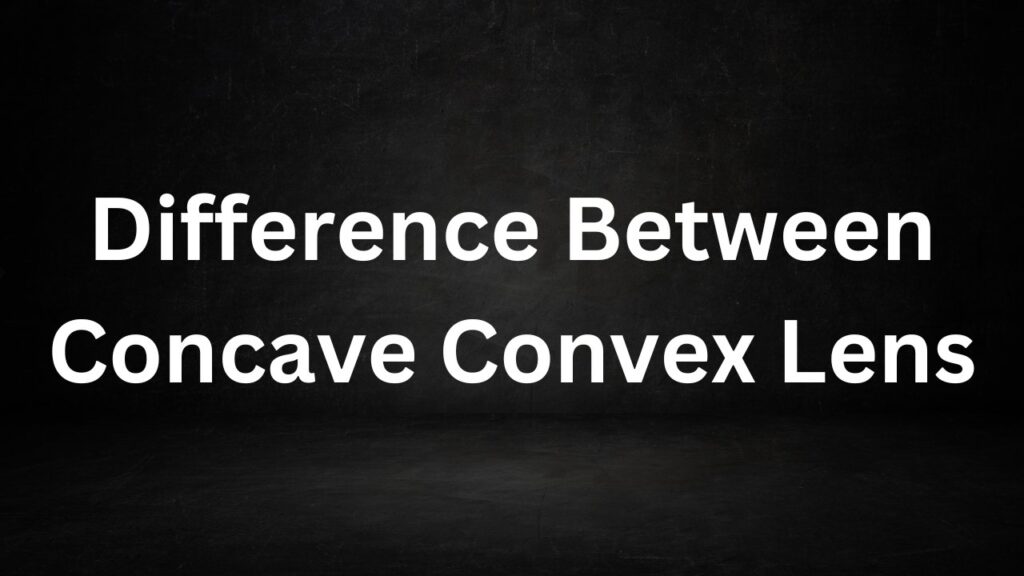Tag: similarities between concave mirror and convex lens
Difference Between Concave Convex Lens
Difference Between Concave Convex Lens: Lenses are essential optical components that play a crucial role in various optical devices, including cameras, telescopes, microscopes, and eyeglasses.
Among the different types of lenses, concave and convex lenses are two primary categories, each with distinct properties and applications. In this article, we will delve into the key differences between concave and convex lenses, their shapes, characteristics, and applications.

Difference Between Concave Convex Lens
Concave Lens:
1. Shape and Structure:
- A concave lens is thinner at the center and thicker at the edges. It curves inward, resembling a cave or a bowl.
- The lens has two curved surfaces: one concave (curving inward) and one flat.
2. Light Refraction:
- When parallel rays of light pass through a concave lens, they diverge or spread apart.
- The point from which the diverging rays appear to originate is called the focal point (F), which is on the same side as the object.
3. Image Formation:
- A concave lens forms virtual, upright, and diminished images for real objects placed beyond its focal point.
- It can also create a virtual image for an object placed between the lens and its focal point.
4. Applications:
- Concave lenses are commonly used in corrective eyeglasses to treat nearsightedness (myopia).
- They are also used in devices like movie projectors to spread out the light from a small source and create a larger image.
Convex Lens:
1. Shape and Structure:
- A convex lens is thicker at the center and thinner at the edges. It bulges outward, resembling a lentil or a magnifying glass.
- The lens also has two curved surfaces: one convex (curving outward) and one flat.
2. Light Refraction:
- When parallel rays of light pass through a convex lens, they converge or come together.
- The point where the converging rays meet is called the focal point (F), which is on the opposite side of the object.
3. Image Formation:
- A convex lens forms real, inverted, and magnified images for objects placed beyond its focal point.
- It can also create virtual, upright, and magnified images for objects placed between the lens and its focal point.
4. Applications:
- Convex lenses are widely used in eyeglasses to correct farsightedness (hyperopia) and presbyopia.
- They are essential components in cameras, telescopes, and microscopes for focusing and magnifying distant or small objects.
Key Differences:
- Shape: Concave lenses are thinner at the center and thicker at the edges, while convex lenses are thicker at the center and thinner at the edges.
- Light Refraction: Concave lenses diverge incoming light rays, while convex lenses converge them.
- Focal Point: In concave lenses, the focal point is on the same side as the object, while in convex lenses, it is on the opposite side.
- Image Formation: Concave lenses produce virtual and diminished images for objects beyond the focal point, while convex lenses create real and magnified images for such objects.
- Applications: Concave lenses are used for correcting nearsightedness and in devices like projectors. Convex lenses are used for correcting farsightedness and in optical instruments like cameras, telescopes, and microscopes.
In summary, concave and convex lenses have distinct shapes, behaviors, and applications in optics. Their ability to refract light in different ways makes them invaluable in a wide range of optical systems and corrective lenses, enhancing our ability to see and manipulate the world around us.
Read More
- Difference Between Electric Field And Magnetic Field
- Difference Between Transducer And Sensor
- Difference Between Alternator And Generator
- Physical & chemical properties of water
- Difference Between Fuse And Circuit Breaker
Frequently Asked Questions (FAQs) Difference Between Concave Convex Lens
1. What are concave and convex lenses primarily used for?
Concave lenses are often used in eyeglasses to correct nearsightedness, while convex lenses are used to correct farsightedness. Both types are used in various optical devices, including cameras, telescopes, and microscopes.
2. How do concave and convex lenses differ in their shape and curvature?
Concave lenses are thinner at the center and thicker at the edges, curving inward. Convex lenses are thicker at the center and thinner at the edges, bulging outward.
3. What happens to light when it passes through a concave lens?
When parallel rays of light pass through a concave lens, they diverge or spread apart. This lens is known for causing light to diverge.
4. What is the focal point, and how does it differ for concave and convex lenses?
The focal point is the point where parallel rays of light either converge or appear to diverge from after passing through the lens. For concave lenses, the focal point is on the same side as the object, while for convex lenses, it is on the opposite side.
5. How do concave and convex lenses differ in terms of image formation?
Concave lenses form virtual, upright, and diminished images for real objects placed beyond the focal point. Convex lenses form real, inverted, and magnified images for objects beyond their focal point.